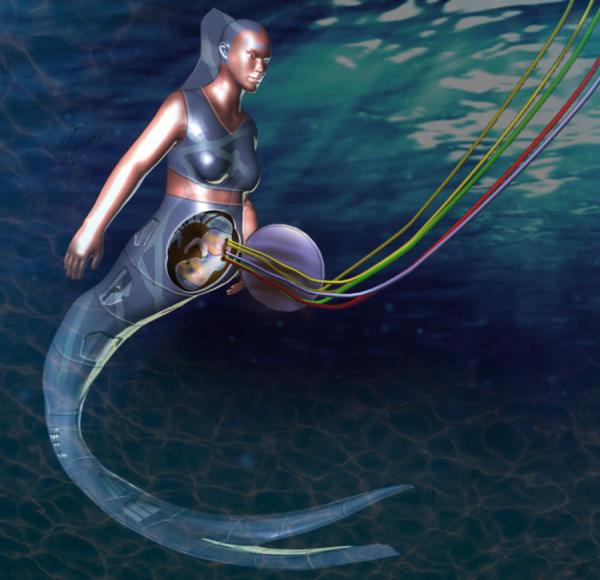BY LETTER
Cyborg Reproduction
Technology > Application > Augmentics
Culture and Society > Family and Community > Childrearing
Culture and Society > Cultures and Sub-Cultures > Cyborgs
Technology > Application > Medical Treatment
Culture and Society > Family and Community > Childrearing
Culture and Society > Cultures and Sub-Cultures > Cyborgs
Technology > Application > Medical Treatment
 Image from Steve Bowers | |
| A nearbaseline human who has several non-biological replacement parts; part of the skull, three limbs with various designs and transparent skin. Several organs have also been replaced and bones strengthened. | |
However, many cyborgs are members of groups which resemble each other, and share many design features in common, sometimes because of fashions in augmentation, and sometimes because the pattern of augmentation is transferred to the individual at birth. Cyborg characteristics can therefore be divided into two main classes
1/ acquired augmentations that have been added after birth, generally well into adulthood; and
2/ inherited augmentations that are introduced into the body during gestation and which grow in parallel with the organic tissues,and continue to grow and self-repair in situ for the rest of the life of the individual.
Acquired augmentations
Historically most cyborgs have been the result of augmentations acquired long after their birth. Although many cyborgs are entirely unique and idiosyncratic in design, trends in augmentation design and popular culture often result in a set of common features that many cyborgs in a population may share. For instance many cyborgs in the Red Star M'Pire have adopted luminous outer skins, allowing them to communicate with other inhabitants of that empire who use a light-based language. In addition many non-cyborged individuals who migrate to a planet with particular environmental requirements will often adopt cyborgisation that allows them to tolerate and thrive in those conditions.Because of these trends and necessities, very often the cyborg population of a particular world or environment will tend to share many characteristics in common, even if their original form were very different; this makes them appear externally quite similar to one another, and such self-similar groups are often regarded as having formed a self-perpetuating clade (even though what little remains of their biological bodies belongs to entirely different species). When cyborgs with acquired characteristics are able to reproduce biologically, their offspring will be unaugmented bionts who can then adopt whatever augmentations they require at a later stage. If the biont offspring is not capable of tolerating the local environment they will need to live in special habs (often known as kindergartens), or wear envirosuits until they can be augmented appropriately. A small but non-zero fraction of cyborg children decline to be augmented in this way, and become normal members of their biological clade - in the past these individuals were shunned or exiled by the cyborg community, but (in the Sephirotic Empires at least) this form of intolerance is practically a thing of the past.
Inherited Augmentations
 Image from Steve Bowers | |
| A Merborg on FuMa recieves some nourishing feedstock to facilitate the growth of her augmented foetus | |
Often the developing cyborg foetus will require complex inorganic feedstocks and organic compounds not normally found in biological bloodstreams, so various methods are employed to enhance the nutrient supply to the womb. In an artificial womb this is relatively straightforward, but often a pregnant cyborg will find emself hooked up to a nutrient supply for part of the day.
A child who has inherited such augmentations can generally start learning to use them almost immediately, and can inhabit the same environment as eir parents. For this reason an increasing number of cyborg clades, who originally had acquired augmentations only, have adopted some form of inherited augmentation.
Clade Cyborn has taken this strategy to an extreme; the cybershell is grown according to a predetermined design, and biont tissue is distributed throughout the shell as required, so that the resulting cyborg conforms to the Cyborn pattern and bears little resemblance to the species that was the origin of the tissue.
Cyborgisation through engeneration
A third form of cyborg reproduction is also common, especially in new colonies. By uploading non-destructively then downloading into a new body, a biont can engenerate a new body for emself with arbitrary characteristics. Especially when migrating to an environment which requires particular adaptations, a biont might download into a cyborg body which is radically different to eir original state. This produces a newly cyborgised individual relatively quickly, but the downloaded individual often finds it difficult to adapt to their new capabilities. For this reason, specialised forms of tachydidaxy and download egress remediation treatment are used to help with the transition.Related Articles
- Augmentation
- Cyborn
- Cyborn, Clade
- FuMa
- Neumann (Von Neumann Self-Replicating Systems)
- Replication - Text by M. Alan Kazlev
The basic process of reproduction for information, whether biological, alife, nanological, memetic, or other; and the means by which genetic or instructional information is propagated. - Reproductive Counselors
- Reproductive Technologies
Appears in Topics
Development Notes
Text by Steve Bowers
Initially published on 03 July 2018.
Initially published on 03 July 2018.






